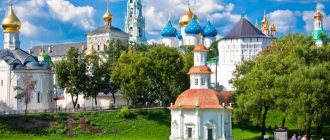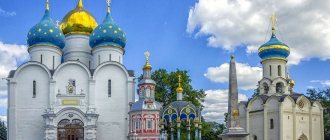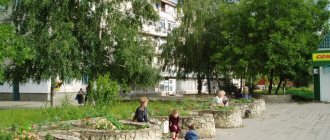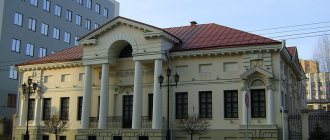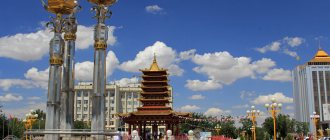The legend about the founding of the city says that the future great prince of Kiev Yaroslav Vladimirovich, while still the prince of Rostov the Great, once traveled around his possessions and met in a place where the two Volga rivers and its tributary Kotorosl merge, an unknown tribe of pagans. The aborigines greeted the prince unfriendly and unleashed a ferocious bear on him. The prince was not afraid and defeated the beast with an axe. And then the pagans submitted to the prince. And he decided to found a city with a fortress here, so that ships with various goods could freely sail along the Volga, so that trades and crafts could develop here. The city was named Yaroslavl in honor of the founder.
Yaroslavl arose as the first Christian city on the Volga. And this was in 1010. Since then, a beautiful city has stood above the Volga, delighting and surprising citizens and its guests with amazing churches and architectural ensembles, cozy squares and original new buildings. And Yaroslavl never changed its name.
Monument to Yaroslav the Wise. Sculptor O.K. Komov. Photo: babiy.svetlana25
Having a very strategically advantageous geographical position, the city became a stronghold of princely power and an outpost for the spread of Christianity in the North-East of Rus'. Already in the 12th-13th centuries, Yaroslavl became one of the most developed cities of Rus', a major center of trade and craft. Metalworking, pottery production, and construction have reached a high level. Merchants conducted brisk trade with other Russian lands, primarily with Novgorod and Pskov. Strong business relations have been established with countries of the East and West, especially with Scandinavia - the city is mentioned in the Scandinavian sagas. Yaroslavl became a center of transit trade; goods from Northern Europe and the East passed through the region along the Volga-Caspian route; eastern merchants were frequent guests in the Yaroslavl region.
Dawn over Yaroslavl Milkov. XI century. Milkov G. A.
Model of Yaroslavl, XIII century
Yaroslavl developed not only as a trade and craft center, but also as a cultural center. The development of books, the spread of education and a high level of literacy in various social strata of the population, the emergence of local chronicles, and the formation of traditions of architecture and painting predetermined the economic and cultural prosperity of the Volga city.
The Yaroslavl rulers were comrades-in-arms of the Grand Dukes of Moscow in both domestic and foreign policy struggles. Yaroslavl residents were among the first to respond to the call of Moscow Prince Dmitry Donskoy, taking part in the Battle of Kulikovo. The battle with the army of Khan Mamai marked the beginning of the liberation of Rus' from the Tatar-Mongol yoke and the unification of Russian lands. In mid-1463, the Yaroslavl principality joined the centralized Moscow state.
In the 15th century, when it joined the Moscow state, the city was given the honorable role of “sovereign fatherland”. In the 17th century, the Moscow kings bequeathed Yaroslavl and its volosts to the direct heirs of the throne in their spiritual letters. The state treasury was transported here in case of danger.
At the beginning of the 17th century, Yaroslavl played a key role in the events of the Time of Troubles, becoming the center of the fight against foreign invaders. In 1609, the city heroically withstood the siege of the Polish-Lithuanian invaders. In 1612, Yaroslavl served as the temporary capital of Russia: the People's Militia under the leadership of Kuzma Minin and Dmitry Pozharsky were stationed here. The highest bodies of state power were created in Yaroslavl: the “Council of the Whole Earth” was convened, orders were organized - all-Russian bodies of territorial and sectoral administration, a mint was built. The “Council of the Whole Earth” included representatives of the nobility, townspeople, Cossacks, archers, and gunners. Yaroslavl, the capital of the Militia, became the center from which the ideas of national unity of the Russian lands emanated. During their stay on Yaroslavl soil, the militia grew from three thousand people to twenty thousand. Having accumulated strength and received financial support from Yaroslavl merchants, it marched on Moscow and liberated the capital. Yaroslavl became a stronghold of Russian statehood: the ideas of national unity, legitimate power, and protection of state interests found their embodiment here. Here the Russian people felt themselves to be a single nation.
The election of a legitimate monarch, Mikhail Romanov, to the kingdom marked the beginning of the restoration of the country after the Time of Troubles. Upon his accession to the throne, the tsar did not forget about the merits of the Yaroslavl people, subsequently providing assistance and support to the city.
Defense of the Spassky Monastery from the Poles in May 1609. Hood. Nekrasov A.P. 1960
The exit of the militia of Minin and Pozharsky from Yaroslavl in July 1612. Nekrasov A. P. 1960
Monument-stele “Oath of Prince Pozharsky”. Artist Nesterenko V.I. Photo: za7verst.ru
In the “necklace” of Russian cities around Moscow, which has received the beautiful name “Golden Ring of Russia,” Yaroslavl is often compared to a pearl of unique beauty. The city is rightfully included in the treasury of world cultural heritage. The heyday of Yaroslavl architecture began in the 16th-17th centuries, and this was associated with the rapid pace of development of the city as the largest commercial, industrial, and transport center of the country, and its increased political authority after overcoming the Time of Troubles. Yaroslavl at that time was the second largest city in Russia after Moscow. At this time, the original character of its architecture emerged: the abundance of decor, the cathedral, majestic type of temples, the grandeur of wall paintings, the special solemnity of icons. The Church of Elijah the Prophet, admiring its frescoes, and the unique 15-domed Church of John the Baptist stand on a par with the works of world architecture.
Church of John the Baptist, 17th century
View of the city of Yaroslavl. Engraving by Rostovtsev A.I.
The city's first stone residential buildings are the most valuable monuments of Russian civil architecture. The central part of Yaroslavl, built according to the regular plan of 1778 approved by Catherine the Great, is a remarkable example of urban planning art of the Classical era. Buildings in the Art Nouveau style at the turn of the 19th and 20th centuries are real architectural pearls of the city landscape. The radial-ring development of the city has survived to this day and has become a real “highlight” of urban planning not only in Yaroslavl, but throughout Russia.
Throughout its history, Yaroslavl took an active part in protecting its native land from external enemies. The services of Yaroslavl residents to the Fatherland, their heroic deeds at turning points in history are a worthy example for current generations, instilling in citizens a sense of pride and patriotism.
Yaroslavl is the center of the Yaroslavl-Rostov diocese with more than a thousand years of history. The diocese has always been known for its ascetics: three bishops who headed it at different periods of history were ordained Patriarch of Moscow and All Rus', eight were canonized. Many names sacred to Russians are associated with the Yaroslavl land: St. Leonty of Rostov, one of the first preachers of Christianity in Rus'; St. Sergius of Radonezh, highly revered by Russians; defenders of the Fatherland - the blessed Prince Alexander Nevsky and Admiral Fyodor Ushakov and many, many others.
Holy Vvedensky Tolga Convent. Photo: tourister.ru
Industry
The 18th century was a turning point for the city. With the construction of St. Petersburg, the city's economic reorientation is taking place from a trade to a production and industrial basis. Yaroslavl is one of the most important centers of industrial development in Russia. At the beginning of the 18th century, by decree of Peter I, the Yaroslavl Great Manufactory was founded - one of the largest linen production facilities in the country. In the 19th century, the active development of industry continued, which led to the creation of large enterprises. The basis of the city's economy was textile, tobacco, chemical and metalworking enterprises.
Yaroslavl large manufactory. Photo: armv.ru
Yaroslavl tobacco factory, 1850. Photo: yarwiki.ru
The favorable location of the city and the flexible policy of local authorities have created favorable conditions for economic activity. Having earned capital from trade operations, Yaroslavl merchants occupied leading positions in the Russian economic elite, influenced political events, earning the favor of tsars and patriarchs. Throughout Russia, the names of major representatives of the Yaroslavl commercial and industrial elite were heard: the Skripins, who ordered the construction of the magnificent temple of Elijah the Prophet, the owners of famous shops, the Eliseev brothers, the “vodka king of Russia”, “millionaire” Pyotr Smirnov, the “kings of the iron market” Pastukhovs, successful entrepreneurs and philanthropists Dunaevs, Vakhromeevs and Olovyanishnikovs.
During the period of modern and recent history, the importance of the city as a large industrial and cultural center of Russia has increased. The 20th century gave a powerful impetus to the development of industrial production in Yaroslavl. Compared to many cities in Central Russia, the city occupies a leading economic position.
Truck from the Yaroslavl Automobile Plant
Rubber-asbestos plant, 1929. Photo: yarwiki.ru
Since the first five-year industrialization plans, the city has played a prominent place in the plans for the transformation and economic recovery of the Soviet state. The presence of a well-developed infrastructure, transport communications, highly qualified workers, and a research and production base created the prerequisites for the transformation of Yaroslavl into the largest industrial and transport center of the country. By the 1950s, the city entered the top twenty largest industrial cities of the Soviet Union. Yaroslavl became a city of industrial giants. Soviet times left their mark on the appearance of Yaroslavl. The rapid development of industry and transport determined its further transformation into a modern city. During the years of Soviet power, Yaroslavl was dressed in the greenery of parks, gardens and lawns, and became one of the greenest and most comfortable cities in the Volga region.
In 1971, the city of Yaroslavl was awarded the Order of the Red Banner of Labor. In 1985, on the occasion of the 975th anniversary of Yaroslavl, another award followed - the city received the Order of the October Revolution. The innovative and knowledge-intensive Yaroslavl industry gave the country the first Soviet dump truck, trolleybus, diesel engine, and the world's first synthetic rubber tire. Today the city has a developed diversified industry with high-tech production. Yaroslavl manufacturers of automobile engines, aircraft and automobile tires, paints and chemical products occupy leading positions in Russia. The high potential for economic growth attracts Russian and foreign investors to the Yaroslavl industry.
Assumption Cathedral
It was built in 1215 on the territory of the Kremlin by Prince Konstantin Vsevolodovich. The Assumption Cathedral became the first stone church in young Yaroslavl. Rebuilt several times. As a result of a fire in 1501, the temple was badly damaged; during the clearing of the rubble, the relics of the 13th century princes Vasily and Constantine were discovered, which became the main shrine of the temple for many years. In 1937, the Assumption Cathedral was blown up, and a cultural park was developed in its place. In 2004, large-scale work began on the construction of a copy of the Assumption Cathedral on the same site; in 2010, the first divine services were held in the temple, conducted by Patriarch Kirill.
Talents and achievements
The city gave Russia its first publicly accessible national theater, founded by the son of a merchant Fyodor Volkov in 1750. The most famous monument of ancient Russian literature, “The Tale of Igor’s Campaign,” which had a significant influence on the development of world artistic culture, was found in Yaroslavl. The Yaroslavl land raised the world's first female cosmonaut, Valentina Vladimirovna Tereshkova, who went into space in 1963. For the first time, the Russian animated film “The Old Man and the Sea” by Yaroslavl animator Alexander Petrov received the American Film Academy Oscar.
The first person to fly into space, Yu. A. Gagarin and the first female cosmonaut V. V. Tereshkova.
Artist Petrov A.K., Oscar winner
Drama Theater named after Fyodor Volkov
The very first Russian theater, the Volkovsky Theater in Yaroslavl, celebrated its 260th anniversary in 2010. In those distant times, on the site of the modern theater there was a leather barn, in which Fyodor Volkov, the son of a merchant, began to hold the first theatrical performances. The first play performed was Esther, created by Rosin and translated by Volkov himself. The history of the theater includes many significant events; at the end of the 19th and beginning of the 20th century, the theater was already known throughout Russia. In 1911, the construction of a new building of the Volkovsky Theater was completed under the direction of architect Nikolai Spirin. This building can be seen in Yaroslavl today, it still houses one of the best theaters in Russia.
Architecture
The unique urban structure of Yaroslavl has received recognition from the world cultural community. By the decision of the 29th session of the UNESCO World Heritage Committee in 2005, the historical center of the city was included in the UNESCO World Heritage List as an urban monument. Yaroslavl became the third Russian city after St. Petersburg and Veliky Novgorod to be included in the honorary list of world architectural monuments. In the UNESCO zone of our city there are 140 architectural monuments, including unique temple buildings of the 16th-18th centuries.
Northern Railway Administration. Former school for girls of clergy. Photo: szd.rzd.ru
The architectural heritage of the city is distinguished by a high degree of preservation of monuments and the historical environment as a whole, reflecting the successive process of development from the ancient city to the present day. Objects of architectural heritage are original buildings that have been preserved without significant alterations. The uniqueness of Yaroslavl is that on its territory there are buildings of almost all styles of Russian architecture of several centuries.
Yaroslavl for tourists
The image of ancient Russian Yaroslavl is familiar to many of us not only from the 1000 ruble banknote, but also from history textbooks, films and books. Moreover, each of us has a chance to see this wonderful city “live” by going on a tour of the Golden Ring of Russia.
It is unlikely that on the territory of our Motherland there will be many cities similar to Yaroslavl, in which you can see almost all directions inherent in Russian architecture from the 16th to the 20th century. In total, Yaroslavl has 140 striking architectural monuments.
Cosmopolitan city
Yaroslavl is a Russian city in essence, but multinational and multi-confessional in character. Tolerance, peace and harmony always reign here. There are 19 national diasporas and communities in the city, a synagogue, a mosque, a Lutheran church have been opened - and Yaroslavl has never known ethnic or religious strife. It was here that one of the first regional branches of the Assembly of Peoples of Russia was opened in the country, uniting Belarusians and Ukrainians, Tatars and Poles, Georgians and Armenians, Chechens and Ingush, Azerbaijanis and Ossetians, Germans and Jews.
The successful cooperation of the city mayor’s office with the Yaroslavl national communities, the peaceful coexistence and creative interaction of people of different nationalities is an example for solving ethnic problems in other regions of Russia.
Yaroslavl constantly maintains and develops friendly relations with cities of many countries of the world, including seven foreign sister cities: Jyvaskylä (Finland), Poitiers (France), Coimbra (Portugal), Kassel and Hanau (Germany), Burlington (USA), Exeter (UK). For its great contribution to the development of international relations in 2003 and 2007, Yaroslavl was successively awarded two high awards - the Flag of Europe and the Badge of Honor of the Council of Europe, awarded by the Parliamentary Assembly of the Council of Europe.
People have always formed the basis of Yaroslavl's outstanding achievements. The focus on leadership and success, energy and entrepreneurship, curiosity and creativity of Yaroslavl residents have become the foundation for the dynamic development and prosperity of the city.
The battle of Yaroslavl with the Tatars on Tugovaya Mountain
Yaroslavl. Tugova mountain. Old postcard
Let us open a few more pages of the historical and toponymic past of Yaroslavl. The threat of the Horde invasion did not bypass the northern Yaroslavl principality. The city was burned, and the first Yaroslavl prince Vsevolod died in an unsuccessful battle for the Russians on the City River. However, Yaroslavl did not resign itself. In 1257, the townspeople rebelled. According to legend, the Yaroslavl people, led by Prince Konstantin, met the Tatar detachment beyond Kotorosl, on a small hill, which later received the name Tugovaya Mountain. Although the Yaroslavl people fought bravely, this time the forces were unequal. The fallen Russian soldiers were buried here, on Tugovaya Mountain. Subsequently, popular rumor began to associate the name of the mountain with this event. According to legend, women continued to come to the hill for a long time to “grieve” for the fallen and mourn them. “There-Sadness” supposedly became the main title. It still seems that this legend is a later speculation. The chronicles are silent about the battle of the Yaroslavl people with the Tatars, and the reign of Constantine in Yaroslavl itself is established only indirectly. More likely something else. You can try to explain the name of Tugovaya Mountain through data on the funeral rite of the Volga Finnish tribes. It is known that among a number of these tribes, those who died in winter were not buried, but hung on trees. We know about this, in particular, from folklore mtaeril. In a Mordovian song, a dying girl asks her relatives: Don’t bury me, mother, in the cemetery, Bury me, mother, near the high road, Near the high road, on an old oak tree... (See A. Shakhmatov. Mardovsky ethnographic collection. St. Petersburg, 1910, p. 193, 436, 448) There is other evidence. In the spring, the dead were removed and buried right there, under the trees. Relatives had to cry over the grave for three days. The place where this ritual was performed was called the “mountain of crying.” It is known that there was a cemetery on Tugovaya Mountain for a long time. A natural question arises: is the name of the mountain connected with this ancient funeral rite? However, for now this is nothing more than a guess.
thousand year old city
Yaroslavl celebrated its thousandth birthday solemnly and widely. On September 10-12, the city hosted festive events dedicated to the great anniversary of one of the oldest cities in our country.
Yaroslavl has written many bright pages in history, contributing to the strengthening of Russian statehood, economy, culture, and the country's defense capability. Members of official delegations, Yaroslavl residents, and numerous Russian and foreign guests of the city took part in the anniversary celebrations. As part of the celebration, the opening of the monument “1000th anniversary of the city of Yaroslavl”, the grand opening of the second stage of the Yaroslavl Zoo took place, concerts of Russian pop stars and creative groups, sports and youth programs, exhibitions, and creative events took place.
Climate
The climate of the city of Yaroslavl is moderate - continental, formed under the influence of the Atlantic Ocean. 150 days a year with temperatures below zero. 590 mm of precipitation falls per year. Most of them fall during the warm period. Winter in Yaroslavl is moderately cold and moderately snowy. It lasts for more than five months. The average January temperature is −11 °C, rarely dropping below 30 °C. There are thaws in winter. The average height of snow cover is 35 – 50 cm, sometimes up to 70 cm. Snow cover appears in the second half of November and persists for 140 days. Winds predominate from southern and western directions. The average wind speed is 4.2 m/s, sometimes more than 8 m/s. Summers are moderately warm and humid. The average July temperature is +18 °C, sometimes up to +37 °C
